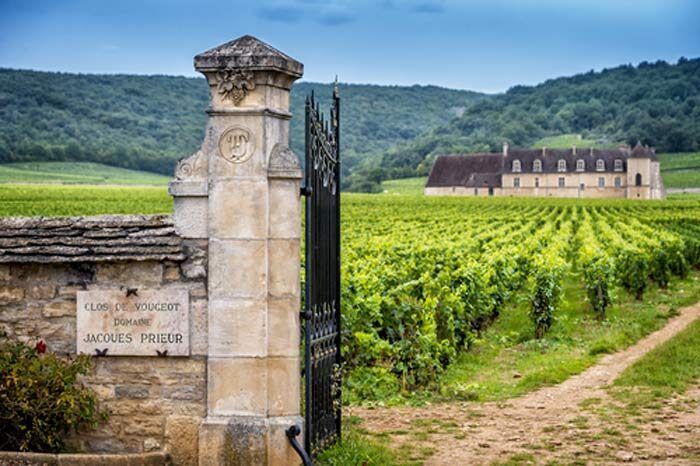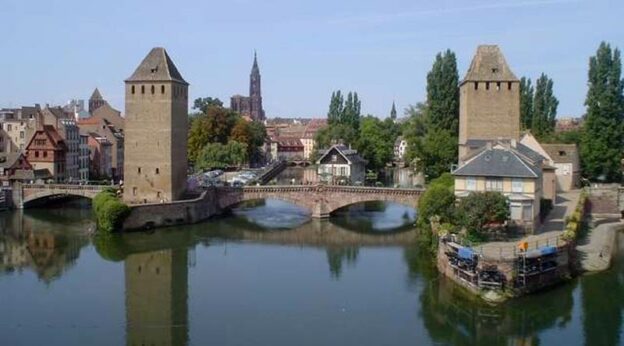With its rich history and remarkable heritage, France invites visitors to explore its UNESCO-recognised masterpieces — sites of outstanding universal value and living symbols of historical memory and traditional know-how. As of 2019, France is home to 45 UNESCO World Heritage sites, many of which are located near its magnificent vineyards — perfect destinations for a wine-themed getaway.
France’s vineyard heritage is proudly represented on the UNESCO List with Saint-Émilion (inscribed in 1999), and the Burgundy Climats and Champagne Hillsides, Houses and Cellars (both added in 2015). Let’s take a closer look at the main UNESCO sites found in France’s great wine regions.
UNESCO sites in Alsace
Alsace is home to four UNESCO World Heritage sites.
In Strasbourg, the Grande Île — the city’s historic heart — is a masterpiece of medieval urban design. Nestled within it, the Petite France quarter exudes a romantic, picturesque atmosphere with its wooden bridges, half-timbered houses, and lively squares such as Place Meunier. A river cruise is a must to take in the charm of this area.
A stroll down the Rue des Orfèvres, known locally as the “Carré d’Or,” reveals exceptional boutiques showcasing Alsatian craftsmanship — all just steps away from the cathedral. Also in Strasbourg, the Neustadt district, built during the Imperial period, features a stunning architectural mix of Art Nouveau, Art Deco, Rococo, Neo-Gothic, Neo-Renaissance, and Haussmannian styles.
Spend 3 days in Strasbourg and its vineyards to discover these architectural gems that have earned a place among the world’s treasures!
Further south, Neuf-Brisach, a small town east of Colmar, was designed in the 17th century by the legendary military engineer Vauban at the request of King Louis XIV. With its immaculate geometric layout, bastioned fortifications, and perfectly preserved structure, it stands as a unique example of military architecture — and is rightly listed as a UNESCO World Heritage site.
In Sélestat, the Humanist Library, designed by architect Rudy Ricciotti, is also UNESCO-listed for housing the oldest preserved manuscripts in Alsace.
UNESCO World Heritage in Burgundy
“Bourgogne” is a land rich with UNESCO treasures — perfect for exploration during your wine trips in Burgundy. Among its listed sites are:
- The Basilica and Hill of Vézelay
- Fontenay Abbey (a Cistercian masterpiece)
- The Saltworks of Salins-les-Bains and Arc-et-Senans
- The Priory of La Charité-sur-Loire (on the Way of St. James)
- The Vauban Fortifications of Besançon
- Notre-Dame-du-Haut in Ronchamp (a work by Le Corbusier)
- The prehistoric pile dwellings of Chalain and Clairvaux
The latest addition, in 2015, was the climats of the Burgundy vineyards, recognized alongside Champagne’s hillsides, houses, and cellars. This inscription celebrates the unique character of Burgundy’s “côte viticole”, stretching from Dijon to Beaune and Santenay. The area is distinguished by its remarkable landscapes, exceptional built heritage, and centuries-old viticultural know-how.
The historic center of Dijon is also included — a city where winegrowing and winemaking have been integral to daily life since the Middle Ages. Each ‘Climat’ (a precisely defined vineyard plot) yields a wine with its own character and appellation — from Régionale to Grand Cru.
Saint-Émilion, near Bordeaux
Listed by UNESCO in 1999 as a cultural landscape, the jurisdiction of Saint-Émilion lies in the Libournais wine region, 35 km northeast of Bordeaux, between Libourne and Castillon-la-Bataille, on the north slopes of the Dordogne Valley.
Covering 7,846 hectares, this vineyard landscape embodies centuries of viticultural tradition and harmony between man, land, and architecture.
UNESCO sites in Champagne
Reims — the city of champagne, but also of coronations and culture — boasts four UNESCO World Heritage sites.
Known as the “City of Coronations,” Reims is steeped in history. During your wine weekend in Champagne, be sure to visit the Reims Cathedral, the former Saint-Remi Abbey, and the Palais du Tau.
In 2015, the Champagne Hillsides, Houses, and Cellars were inscribed, highlighting the landscape that gave birth to the world’s most celebrated sparkling wine.
Nearby Épernay is also a must-see: its Avenue de Champagne, lined with majestic champagne houses, is itself a UNESCO World Heritage site. A perfect starting point for exploring the Champagne Wine Route.
The seven UNESCO sites of Provence
Seven of France’s forty-five UNESCO sites are located in Provence, including:
- The Pont du Gard
- The Roman and Romanesque monuments of Arles
- Le Corbusier’s Cité Radieuse in Marseille
- The Abbey Church of Saint-Gilles-du-Gard
- The Chauvet Cave in Ardèche
- The Ancient Theatre and Triumphal Arch of Orange
While exploring the vineyards around Châteauneuf-du-Pape, make sure to visit Avignon, whose historic center — including the Papal Palace and the world-famous Pont d’Avignon — is also UNESCO-listed.
For more information: https://avignon-tourisme.com/






